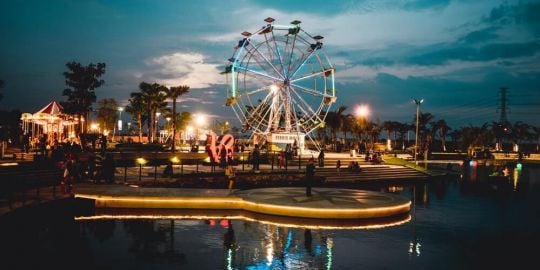𝐃𝐈𝐃 𝐘𝐎𝐔 𝐊𝐍𝐎𝐖?
𝗖𝗲𝗯𝘂 𝗖𝗶𝘁𝘆 ↦ Oldest City in the Philippines
𝗗𝗮𝘃𝗮𝗼 𝗖𝗶𝘁𝘆 ↦ Largest City in the Philippines
𝗧𝗮𝗴𝘂𝗺 ↦ Music Capital of the South
𝗦𝗮𝗺𝗮𝗹 ↦ Phil. Island Garden City
𝗗𝗮𝘃𝗮𝗼 𝗱𝗲𝗹 𝗡𝗼𝗿𝘁𝗲 ↦ Banana Capital
𝗠𝗮𝘁𝗶 ↦ Coconut City of the South
𝗗𝗶𝗴𝗼𝘀 ↦ Clay Capital of Mindanao
𝗠𝗮𝗹𝗶𝘁𝗮 ↦ Banana Capital of Davao
𝗞𝗶𝗱𝗮𝗽𝗮𝘄𝗮𝗻 ↦ City at the foot of Mt Apo
𝗗𝗮𝘃𝗮𝗼 𝗖𝗶𝘁𝘆 ↦ Durian Capital, Cacao Capital
𝗞𝗼𝗿𝗼𝗻𝗮𝗱𝗮𝗹 ↦ Ilonggo City of the South
𝗚𝗲𝗻𝗦𝗮𝗻 𝗖𝗶𝘁𝘆 ↦ Tuna Capital
𝗕𝘂𝗸𝗶𝗱𝗻𝗼𝗻 ↦ Pineapple Capital
𝗠𝗮𝗹𝗮𝘆𝗯𝗮𝗹𝗮𝘆 ↦ Summer Capital of the South
𝗗𝗮𝘃𝗮𝗼 ↦ Fruit Basket and King City of the South
𝗖𝗮𝗴𝗮𝘆𝗮𝗻 𝗱𝗲 𝗢𝗿𝗼 ↦ City of Golden Friendship
𝗜𝘀𝘂𝗹𝗮𝗻 ↦ Oil Palm Capital of the Philippines
𝗖𝗮𝗺𝗶𝗴𝘂𝗶𝗻 ↦ Island Born of Fire
𝗦𝗶𝘁𝗮𝗻𝗴𝗸𝗮𝗶, 𝗧𝗮𝘄𝗶 𝗧𝗮𝘄𝗶 ↦ Venice of the South
𝗖𝗼𝘁𝗮𝗯𝗮𝘁𝗼 ↦ Land of Mightiest Mountain
𝗟𝗮𝗻𝗮𝗼 𝗱𝗲𝗹 𝗦𝘂𝗿 ↦ Cradle of Muslim Art
𝗦𝗼𝘂𝘁𝗵 𝗖𝗼𝘁𝗮𝗯𝗮𝘁𝗼 ↦ Conference Capital of Mindanao
𝗗𝗶𝗻𝗮𝗴𝗮𝘁 𝗜𝘀𝗹𝗮𝗻𝗱 ↦ Mystical Province of Love
𝗦𝘂𝗿𝗶𝗴𝗮𝗼 𝗱𝗲𝗹 𝗡𝗼𝗿𝘁𝗲 ↦ Surfing Capital
𝗟𝗮𝗻𝗮𝗼 𝗱𝗲𝗹 𝗡𝗼𝗿𝘁𝗲 ↦ Land of Beauty and Bounty
𝗢𝗿𝗼𝗾𝘂𝗶𝗲𝘁𝗮 ↦ City of Good Life
𝗭𝗮𝗺𝗯𝗼𝗮𝗻𝗴𝗮 𝗱𝗲𝗹 𝗡𝗼𝗿𝘁𝗲 ↦ Province of South's Twin City
𝗠𝗮𝗴𝘂𝗶𝗻𝗱𝗮𝗻𝗮𝗼 ↦ Seat of Muslim Mindanao
𝗠𝗶𝘀𝗮𝗺𝗶𝘀 𝗢𝗰𝗰 ↦ Christmas Capital of Mindanao
𝗔𝗴𝘂𝘀𝗮𝗻 𝗱𝗲𝗹 𝗡𝗼𝗿𝘁𝗲 ↦ Land of Antiquated Finds
𝗕𝘂𝘁𝘂𝗮𝗻 ↦ Timber City of the South
𝗚𝗶𝗻𝗴𝗼𝗼𝗴 ↦ City of Good Luck
𝗗𝗮𝗽𝗶𝘁𝗮𝗻 ↦ Shrine and Historic City of the South
𝗣𝗮𝗴𝗮𝗱𝗶𝗮𝗻 ↦ Little Hong Kong of the South
𝗭𝗮𝗺𝗯𝗼𝗮𝗻𝗴𝗮 𝗖𝗶𝘁𝘆 ↦ Asias Latin City, Sardines Capital, City of Flowers
𝗦𝘂𝗹𝘂 ↦ Land of Exotic Fruits
𝗜𝗹𝗶𝗴𝗮𝗻 ↦ industrial City of the South
𝗗𝗶𝗽𝗼𝗹𝗼𝗴 ↦ The Phil. Orchid City
𝗟𝗮𝗻𝘁𝗮𝗽𝗮𝗻, 𝗕𝘂𝗸𝗶𝗱𝗻𝗼𝗻 ↦ Vegetable Basket of Mindanao
𝗔𝗸𝗹𝗮𝗻 ↦ Oldest province in the Philippines
𝗔𝗻𝘁𝗶𝗾𝘂𝗲 ↦ Province where the mountain meets the sea
𝗔𝗻𝘁𝗶𝗽𝗼𝗹𝗼 ↦ City in the Sky
𝗔𝘂𝗿𝗼𝗿𝗮 ↦ Land of Golden Sunrise
𝗔𝗹𝗶𝗺𝗼𝗱𝗶𝗮𝗻, 𝗜𝗹𝗼𝗶𝗹𝗼 ↦ Banana Capital of Panay
𝗕𝗮𝗰𝗼𝗼𝗿 ↦ Band Capital of the Philippines
𝗕𝗮𝗴𝘂𝗶𝗼 𝗖𝗶𝘁𝘆 ↦ Summer Capital/ City of Pines
𝗕𝗮𝘁𝗮𝗮𝗻 ↦ History Hub of Central Luzon
𝗕𝗮𝘁𝗮𝗻𝗴𝗮𝘀 ↦ Diving and Shipping Capital
𝗕𝗮𝘁𝗮𝗻𝗲𝘀 ↦ Land of True Insulars
𝗕𝗮𝗰𝗼𝗹𝗼𝗱 ↦ City of Smiles
𝗕𝗶𝗹𝗶𝗿𝗮𝗻 ↦ Shipyard of Antiquity
𝗕𝗲𝗻𝗴𝘂𝗲𝘁 ↦ Salad Bowl of the Philippines
𝗕𝗼𝗿𝗼𝗻𝗴𝗮𝗻 ↦ King City of the East
𝗕𝗼𝗵𝗼𝗹 ↦ Calamay Capital of the Philippines
𝗕𝘂𝗹𝗮𝗰𝗮𝗻 ↦ Manila's Gateway to the North
𝗖𝗮𝗹𝗯𝗮𝘆𝗼𝗴 ↦ City of Waterfalls
𝗖𝗮𝗶𝗻𝘁𝗮, 𝗥𝗶𝘇𝗮𝗹 ↦ Bibingka Capital
𝗖𝗮𝗹𝗮𝗺𝗯𝗮 ↦ Hot Spring Capital
𝗖𝗮𝗺 𝗦𝘂𝗿 ↦ Wakeboarding Capital
𝗖𝗮𝘃𝗶𝘁𝗲 ↦ Cradle of Phil. Revolution
𝗖𝗮𝘁𝗯𝗮𝗹𝗼𝗴𝗮𝗻 ↦ City of Captivating Contrast
𝗖𝗮𝘁𝗮𝗻𝗱𝘂𝗮𝗻𝗲𝘀 ↦ Land of the Howling Wind
𝗖𝗮𝘂𝗮𝘆𝗮𝗻, 𝗜𝘀𝗮𝗯𝗲𝗹𝗮 ↦ Mushroom City of the North
𝗖𝗲𝗯𝘂 ↦ Gateway to a Thousand Journeys
𝗗𝘂𝗺𝗮𝗴𝘂𝗲𝘁𝗲 ↦ City of Gentle People
𝗗𝗮𝗴𝘂𝗽𝗮𝗻 ↦ Bangus Capital
𝗗𝗼𝗻𝘀𝗼𝗹, 𝗦𝗼𝗿𝘀𝗼𝗴𝗼𝗻 ↦ World's Whale Shark Capital
𝗘𝗮𝘀𝘁𝗲𝗿𝗻 𝗦𝗮𝗺𝗮𝗿 ↦ Gateway to Phil. Discovery
𝗘𝗹 𝗦𝗮𝗹𝘃𝗮𝗱𝗼𝗿, 𝗠𝗶𝘀 𝗢𝗿 ↦ City of Divine Mercy
𝗘𝗹 𝗡𝗶𝗱𝗼 ↦ Heaven on Earth
𝗚𝘂𝗶𝗺𝗮𝗿𝗮𝘀 ↦ Mango County of Visayas
𝗚𝘂𝘁𝗮𝗹𝗮𝗰, 𝗭𝗮𝗺𝗯. 𝗡𝗼𝗿𝘁𝗲 ↦ Pebble Capital
𝗜𝗹𝗼𝗶𝗹𝗼 ↦ Province with most number of barangays
𝗜𝗹𝗼𝗶𝗹𝗼 𝗖𝗶𝘁𝘆 ↦ The First Queen City of the South, City where the Past is always present
𝗜𝗹𝗼𝗰𝗼𝘀 𝗦𝘂𝗿 ↦ Heritage Haven of the Far North
𝗜𝗺𝘂𝘀 ↦ The Philippine Flag Capital
𝗜𝘀𝗮𝗯𝗲𝗹𝗮 ↦ Rice Granary of the North
𝗞𝗮𝗹𝗶𝗻𝗴𝗮 ↦ White Rafting Capital of the North
𝗟𝗮 𝗨𝗻𝗶𝗼𝗻 ↦ Surfing Capital of the North
𝗟𝗮𝗴𝘂𝗻𝗮 ↦ The Silicon Valley
𝗟𝗮 𝗧𝗿𝗶𝗻𝗶𝗱𝗮𝗱, 𝗕𝗲𝗻𝗴𝘂𝗲𝘁 ↦ Strawberry Capital
𝗟𝗮𝘀 𝗣𝗶𝗻𝗮𝘀 ↦ Salt Center of Metro Manila
𝗟𝗲𝗴𝗮𝘇𝗽𝗶 ↦ City of Fun and Adventure, ATV capital
𝗟𝗶𝗽𝗮, 𝗕𝗮𝘁𝗮𝗻𝗴𝗮𝘀 ↦ City of Pride
𝗟𝗶𝗻𝗴𝗮𝘆𝗲𝗻 ↦ The Most Romantic Place
𝗟𝘂𝗰𝗲𝗻𝗮, 𝗤𝘂𝗲𝘇𝗼𝗻 ↦ Biofuel & Biopalm City
𝗠𝗮𝗮𝘀𝗶𝗻 𝗖𝗶𝘁𝘆, 𝗦. 𝗟𝗲𝘆𝘁𝗲 ↦ The Religious City
𝗠𝗮𝗸𝗮𝘁𝗶 ↦ Manhattan of the Philippines
𝗠𝗮𝗿𝗶𝗸𝗶𝗻𝗮 ↦ Shoe Capital of the Philippines
𝗠𝗮𝘀𝗯𝗮𝘁𝗲 ↦ Great Wild West of Phil.
𝗠𝗮𝗻𝗶𝗹𝗮 ↦ Ever Distinguished Loyal City
𝗠𝗮𝗿𝗶𝗻𝗱𝘂𝗾𝘂𝗲 ↦ Heart of the Philippines
𝗠𝗮𝗻𝗱𝗮𝘂𝗲 ↦ Furniture Capital
𝗠𝗮𝗻𝗱𝘂𝗹𝘂𝘆𝗼𝗻𝗴 ↦ Shopping Capital
𝗠𝗶𝗮𝗴𝗮𝗼, 𝗜𝗹𝗼𝗶𝗹𝗼 ↦ Municipality with most number of barangays, Onion Capital of Visayas
𝗠𝗼𝗹𝗼, 𝗜𝗹𝗼𝗶𝗹𝗼 ↦ Athens of the Philippines
𝗠𝘂𝗻𝘁𝗶𝗻𝗹𝘂𝗽𝗮 ↦ The Emerald City
𝗡𝗮𝗴𝗮 ↦ Bicols Queen City
𝗡𝗮𝘃𝗼𝘁𝗮𝘀 ↦ Fishing Capital of Greater Manila
𝗡𝗲𝗴𝗿𝗼𝘀 𝗢𝗰𝗰𝗶𝗱𝗲𝗻𝘁𝗮𝗹 ↦ Sugar Bowl
𝗡𝗲𝗴𝗿𝗼𝘀 𝗢𝗰𝗰𝗶𝗱𝗲𝗻𝘁𝗮𝗹 ↦ Province with most number of cities
𝗡𝗲𝗴. 𝗢𝗿𝗶𝗲𝗻𝘁𝗮𝗹 ↦ Whale and Dolphin Haven
𝗡𝘂𝗲𝘃𝗮 𝗘𝗰𝗶𝗷𝗮 ↦ Rice Granary of the Philippines
𝗡𝘂𝗲𝘃𝗮 𝗩𝗶𝘇𝗰𝗮𝘆𝗮 ↦ Watershed Haven of Cagayan Valley
𝗢𝗿𝗶𝗲𝗻𝘁𝗮𝗹 𝗠𝗶𝗻𝗱𝗼𝗿𝗼 ↦ Harbor Gateway to the South
𝗣𝗮𝗹𝗮𝘄𝗮𝗻 ↦ Largest Province in the Philippines
𝗣𝗮𝗹𝗮𝘄𝗮𝗻 ↦ Philippines' Last Frontier
𝗣𝗮𝗺𝗽𝗮𝗻𝗴𝗮 ↦ Culinary Capital of the Philippines
𝗣𝗮𝗻𝗴𝗮𝘀𝗶𝗻𝗮𝗻 ↦ Saltmaking Capital
𝗣𝗮𝘁𝗲𝗿𝗼𝘀 ↦ Balut Capital
𝗣𝗮𝗿𝗮𝗻𝗮𝗾𝘂𝗲 ↦ Fashion Capital
𝗣𝗮𝘀𝗮𝘆 ↦ Travel Capital
𝗣𝗮𝘀𝘀𝗶 ↦ Sweet City at the Heart of Panay
𝗣𝗼𝘁𝗼𝘁𝗮𝗻, 𝗜𝗹𝗼𝗶𝗹𝗼 ↦ Christmas Capital of Visayas
𝗣𝘂𝗲𝗿𝘁𝗼 𝗚𝗮𝗹𝗲𝗿𝗮 ↦ Mini Boracay
𝗣𝘂𝗲𝗿𝘁𝗼 𝗣𝗿𝗶𝗻𝗰𝗲𝘀𝗮 ↦ EcoTourism Capital
𝗤𝘂𝗲𝘇𝗼𝗻 𝗖𝗶𝘁𝘆 ↦ City of Stars and New Horizons
𝗤𝘂𝗶𝗿𝗶𝗻𝗼 ↦ Forest Heartland of Cagayan Valley
𝗥𝗶𝘇𝗮𝗹 ↦ Cradle of Philippine Arts
𝗥𝗼𝗺𝗯𝗹𝗼𝗻 ↦ Marble Capital
𝗥𝗼𝘅𝗮𝘀 𝗖𝗶𝘁𝘆 ↦ Seafood Capital of the Philippines
𝗦𝗮𝗯𝗹𝗮𝘆𝗮𝗻, 𝗢𝗰𝗰. 𝗠𝗶𝗻𝗱𝗼𝗿𝗼 ↦ Largest Municipality in the Philippines
𝗦𝗮𝗺𝗮𝗿 ↦ Spelunking Capital
𝗦𝗮𝗻 𝗝𝘂𝗮𝗻 ↦ Tiangge Capital
𝗦𝗮𝗻 𝗙𝗲𝗿𝗻𝗮𝗻𝗱𝗼 ↦ Lantern Capital
𝗦𝗶𝗾𝘂𝗶𝗷𝗼𝗿 ↦ Island of Fire
𝗧𝗮𝗿𝗹𝗮𝗰 ↦ Melting Pot of Central Luzon
𝗧𝗮𝗰𝗹𝗼𝗯𝗮𝗻 𝗖𝗶𝘁𝘆 ↦ City of Hope
𝗧𝗮𝗴𝗯𝗶𝗹𝗮𝗿𝗮𝗻 ↦ City of Peace and Friendship
𝗧𝗮𝗴𝘂𝗶𝗴 ↦ The ProvinSyudad
𝗧𝘂𝗴𝘂𝗲𝗴𝗮𝗿𝗮𝗼 ↦ Premier Ybanag City
𝗩𝗮𝗹𝗲𝗻𝘇𝘂𝗲𝗹𝗮 ↦ The Only Divided City
𝗩𝗮𝗹𝗲𝗻𝘇𝘂𝗲𝗹𝗮 ↦ Vibrant City of Discipline
𝗭𝗮𝗺𝗯𝗮𝗹𝗲𝘀↦ Chromite Capital
Credits: Travel Box Ticketing Office










